
Legal
Second California Law That Affects MSOs Passes
California has now passed two laws that will have an effect on how investors, health care entities and management services ...

Show your committment to patient safety, legal compliance and community over competition.
AmSpa members receive preferred pricing on all AmSpa live and virtual trainings.
Get the latest news and information about safe, legal practice in medical aesthetics directly in your inbox.
Get access to med spa laws, in-person and online training and more!
Posted By Mike Meyer, Wednesday, February 24, 2021

By Bradford E. Adatto, Partner, ByrdAdatto
Intravenous (IV) therapy has been used to provide nutrition and for rehydration in hospitals and medical practices for decades. However, in this new day and age, IV therapy is also utilized to treat conditions such as hangovers, fatigue, flu symptoms and jet lag. In July 2017, ByrdAdatto released an article titled "123's of IV Therapy Providers," which discussed the growing business of IV therapy bars and major considerations when providing such services.This update revisits one of the major considerations, the corporate practice of medicine (CPOM), and expands upon compliance issues with the administration of IV services.
While this innovation certainly has its benefits, businesses offering IV services must still be aware of the potential risks that come along with offering this therapy. First and foremost, one must understand that, in most states, the piercing of the outermost layer of the skin or the epidermis and the rendering of fluids and vitamins via a compound is the practice of medicine. When practicing medicine, a business must comply with its state CPOM position.
The CPOM doctrine is a legal doctrine that generally prohibits corporations, entities or non-physicians from practicing medicine. Expanded, it prohibits lay people from owning medical clinics and employing physicians. Each state has its own position with respect to this doctrine—some can be strict, meaning only physicians can own the medical clinic; non-existent, allowing anyone to own a medical practice (although there is still an interference prohibition); or in between, allowing for joint ownership by other health care providers or non-professionals. For example, if a medical spa in California is offering IV therapy, it must be rendered through a medical corporation, and at least 51% of the practice must be owned by a licensed physician or physicians, and the other 49% may be owned by one or more allied health professionals. These allied health professionals may be either a physician assistant (PA), nurse practitioner (NP), registered nurse (RN), or other practitioners specified; however, the number of non-physicians cannot exceed the number of physicians. In New York, an entity rendering IV services must be 100% owned by a physician or a group of physicians.

Not all states have adopted these same ownership restrictions or recognize the CPOM prohibition. For example, in Florida, both physicians and non-physicians may own a medical entity. However, in order to preserve the physician-patient relationship in an entity that is owned by non-physicians, Florida requires the employment of a physician as medical director. Additionally, the medical services must be rendered only by licensed practitioners, and non-physicians cannot interfere with the professional judgment of the physician.
To add to the complexity, in some states, an NP has independent practice authority, which can confuse how this impacts the professional medical services rendered in the state.
Besides CPOM, the chain of care of the patient must be consistent with the diagnoses and treatment requirements of the particular procedure because the practice of medicine is occurring. Once an entity has been established in accordance with the applicable state laws to render IV services, the next part of the equation is determining if the patient is a good candidate for the services. As such, a good-faith exam, or initial evaluation, must be conducted prior to rendering any services. In most states, a physician, PA or NP (and either a PA or NP may be subject to applicable supervision and delegation rules) may perform the good-faith exam. After the good-faith exam is conducted, either the physician, PA or NP will prescribe a course of treatment and will have the ability to delegate the performance of the treatment to a non-physician provider.
The non-physician provider can be a PA, NP, RN, or, in some states, a licensed practical nurse (LPN) or a licensed vocational nurse (LVN). Only a few states allow the administration of IV fluids by a person other than those listed, such as emergency medical technicians or paramedics, in a medical clinic.
Once a treatment is delegated to a non-physician provider, the prescribing provider must meet the applicable supervision rules. These rules can vary from the prescribing provider being on site to the prescribing provider being immediately available in case of emergency.

For example, in California, an RN may administer the IV therapy under the supervision of either a physician, PA or NP. An LVN will be considered competent to start and superimpose IV fluids via a primary or secondary line if they have completed either a nursing board approved intravenous therapy course or submitted certification to prove that they have the knowledge, skills and abilities to safely administer IV services.
New York's regulations are similar to California's, but an LPN must be under the direct supervision of a physician, PA, NP or RN. Further, in order for a LPN to administer IV services, they must have taken the appropriate IV therapy course training.
In Florida, there are restrictions that are similar to those in New York and California for the administration of IV therapy.
One of the most important takeaways from these rules and regulations is to remember that just because a provider may be qualified to administer IV services, this by itself does not mean the provider can form and own an IV bar or business performing IV therapy. Each state has its own rules and regulations outlining who may do what and who may own what. Be sure to check your state's requirements before you start.
AmSpa members receive a complimentary 20-minute Introductory Compliance Assessment with a ByrdAdatto attorney. Click here to learn how to join AmSpa today!

Bradford E. Adatto is a partner at ByrdAdatto, a national business and health care boutique law firm with offices in Dallas and Chicago. His background is in regulatory, transactional and securities law. Having worked in health care law his entire career, he has an in-depth knowledge of the "dos and don'ts" of this heavily regulated industry. Brad has worked with physicians, physician groups, and other medical service providers in developing ambulatory surgical centers, in-office and freestanding ancillary service facilities, and other medical joint ventures. He regularly counsels clients with respect to federal and state health care regulations that impact investments, transactions and contract terms, including Medicare fraud and abuse, antitrust, anti-kickback, anti-referral, and private securities laws.
Related Tags
Medical spa news, blogs and updates sent directly to your inbox.

Legal
California has now passed two laws that will have an effect on how investors, health care entities and management services ...

Legal
A newly passed law in California will prohibit certain contractual provisions between medical and dental practices and private equity groups ...

Legal
By Patrick O'Brien, General Counsel, American Med Spa Association (AmSpa)The September bulletin from the Texas Medical Board (TMB) helps to ...

Legal
By Patrick O’Brien, General Counsel, American Med Spa AssociationOn September 23, 2025, the Alabama Board of Medical Examiners (BME) issued ...